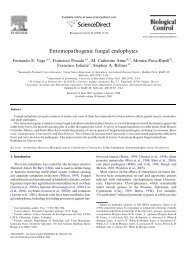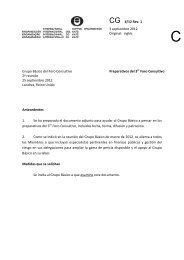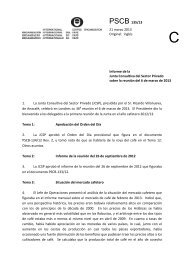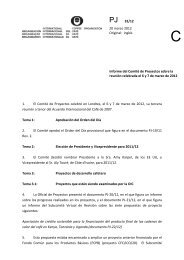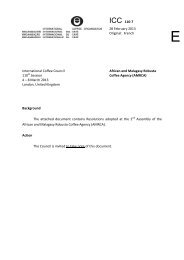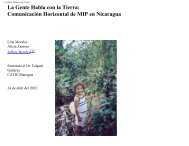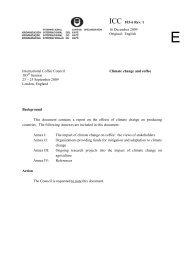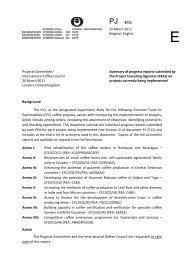Devouring profit - International Coffee Organization
Devouring profit - International Coffee Organization
Devouring profit - International Coffee Organization
You also want an ePaper? Increase the reach of your titles
YUMPU automatically turns print PDFs into web optimized ePapers that Google loves.
104<br />
Currently coffee represents 1.5 % of all Mexican exports. Although this figure is lower<br />
than the Guatemalan and Honduran cases it is still important. For year 2000, Mexico<br />
was the world’s fifth largest exporter of coffee. The value of coffee exports has been<br />
very variable, with an average of about US$530 millions.<br />
Mexico has a population of 100 million people, 71% living in cities and towns and 29%<br />
in rural areas. Hence almost 30 million people are still linked to a largely subsistence<br />
economy. The agricultural contribution to GDP has been decreasing from 16% in 1960<br />
to 5.6% in 1998. This loss in importance has generated problems, for instance in a high<br />
rate of malnutrition. In the opinion of people interviewed during our field visit, food<br />
security is threatened because Mexican staples such as maize and wheat have to be<br />
imported. Mexico, like India is an example of a country where although coffee is not<br />
a major part of the economy, it is a significant factor in the economy of some poor rural<br />
areas.<br />
The area planted to coffee in Mexico increased by about 80% from 1978 to 1992<br />
when it rose from 400,000 hectares to over 700,000. Despite this expansion, total<br />
coffee production has not risen in proportion with this increase (Figure 25).<br />
Despite a large rise in year 1999/00, coffee production on average has been around<br />
4.9 million sacks, similar to the amount for 1989-90. This suggests that new areas are<br />
mostly traditional rather than intensive and it is possible that old areas are being abandoned<br />
or neglected as new areas are planted.<br />
Whatever the reasons, yield per hectare is always below 12 qq 40 of green coffee per<br />
hectare. From the National <strong>Coffee</strong> Survey (1999-2000), of the total coffee area, 93.7%<br />
was in production, 1.3% was in new plantations in the pre-production stage and the<br />
5% was dedicated to roads, buildings, rural paths, etc. (Consejo Mexicano del Café,<br />
2000). Since such a huge percentage was in production and so little under renewal,<br />
this implies that the crop cycle is very long, another indicator of traditional coffee<br />
growing. The Mexican coffee sector employs about 3 million people (Moguel et al.,<br />
1996) i.e. about 10% of the total rural population, which indicates that Mexican coffee<br />
is more important to the country than economic data alone might first suggest.<br />
Colombia<br />
<strong>Coffee</strong> exports have long been a key provider of foreign currency needed for the<br />
growth of other sectors of the Colombian economy. As recently as 1994, coffee exports<br />
of US$1.99 billion represented almost a quarter of the country’s total export<br />
earnings. However, since 1997, Colombia’s export earnings from coffee have fallen<br />
by almost 70%, largely due to a sharp decline in prices. By 2000, coffee exports of<br />
US$1.08 billion represented only 8% of total exports, while in 2001 the figure is<br />
40 1 qq = 1 Quintal = 46 kg




